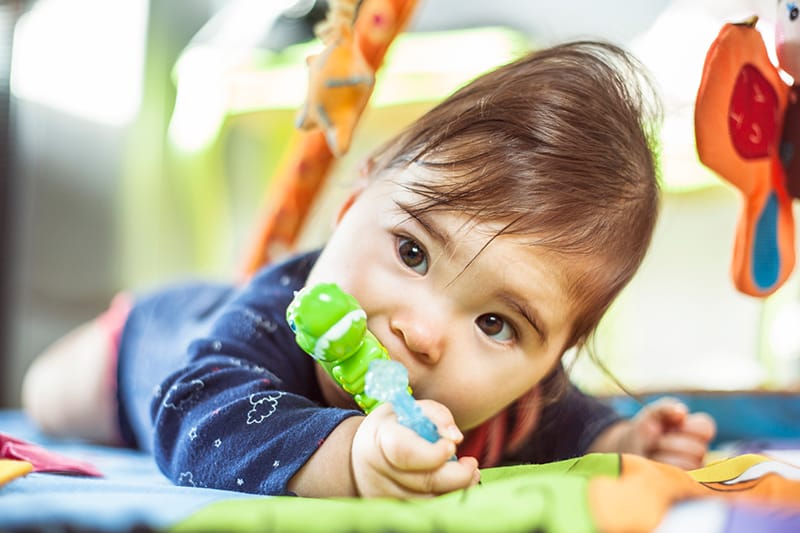Your precious little girl is extra cranky? It must be teething.
Your baby boy has a fever? It's got to be his teeth.
Sleepless night? Teething strikes again.
Teething gets blamed for everything. The truth is that it produces only a few mild symptoms. And the best you can do is provide relief until your child has a full set of baby teeth.
Most symptoms blamed on teething are actually something else.
"A lot of things get blamed on teething even though they aren't necessarily related. The symptoms are rather non-specific and affect children in multiple ways," says Daniel Pelzer, MD, pediatrician at The Iowa Clinic's West Des Moines Campus. "We most frequently see a little bit of irritation, perhaps a couple of days worth, a lot more mucus and oral secretions and maybe some bedtime fussiness. Runnier stools as that mucus makes its way through are also common."
Notably absent from that list: fever. That's the number one thing blamed on teething, but it's much more likely an infection causing your infant to burn up rather than any inflammation from a couple of incisors coming in.
"Anything above 100.4 degrees, fever stage, is likely related to something else. The largest studies on teething suggest that fussiness and increased mucus secretions can be blamed on teething, but fever is likely related to an age-appropriate infection like a cold or a cough," Dr. Pelzer says.
Only a few teething remedies are recommended by pediatricians.
It could be more painful for babies, but cutting teeth is at least mildly uncomfortable. As children get older, they may vocalize their discomfort or show noticeable signs by doing something to calm it like tugging at an ear or applying pressure to their face on the side where a tooth is coming in.
Teething is probably a lot more painful for the parents. It's your job to care for your child and you can't stand to see them experience any amount of pain. That desire to keep baby happy and pain-free can lead to some unproven products in your search for teething relief.
Teething Remedies to Avoid
There are a lot of products out there promising relief for your little ones. They might claim to be more natural, ease inflammation, reduce pain or carry other unproven mystical properties. Avoid them at all costs, Dr. Pelzer says, because they could be dangerous.
- Teething necklaces — "Whenever I see one of these, I tell parents to take it off because it's very dangerous. They are NOT effective and pose a risk of choking and strangulation," he says. Necklaces made of amber, wood, silicone or marble have become a popular teething remedy, claiming to control drooling, release pain-relieving substances that are absorbed through the skin and reduce inflammation in the ears, throat, stomach and respiratory system. However, the Food and Drug Administration (FDA) warned in December 2018 that there is no scientific evidence to support these claims.
- Topical pain relievers — Parents often rub natural or chemical solutions onto the teeth or gums to relieve pain. Dr. Pelzer says topical analgesics have never been proven to be helpful and run the risk of poisoning your child or worse. Products with Benzocaine, like Baby Orajel, were ordered by the FDA in 2018 to be taken off the market for the risk they pose to infants.
- Teething tablets — Homeopathic teething tablets come with a similar warning, with many products known to give babies seizures. They provide only short term relief while putting potentially unsafe toxins directly into your baby's mouth.
- Teething snacks — Cookies, biscuits or healthier options like frozen fruit sound like a better option. But pediatric dentists disagree. These snacks leave a residue on your baby's teeth, which causes tooth decay, and are a choking hazard.
Teething Remedies You Can Trust
The latest new teething products get all the buzz. But the best ways to relieve the pain and discomfort of teething are much simpler and are probably already in your home.
- Cold washcloths — "It's the primary thing we recommend," says Dr. Pelzer. "Washcloths and anything else that can be cooled off in the refrigerator to provide topical relief — the experts say it's the most effective."
- Teething rings and toys — Simple rubber teething toys, especially ones that can be cooled, can provide a little bit of relief to teething discomfort. As long as it's large enough that your baby can't put the whole toy in his or her mouth, it's okay. Avoid the ones filled with liquid though. They can get too hard in the freezer and bruise your baby's sensitive gums.
- Teething necklaces for mom — Those chunky, rubbery necklaces you wear are also okay. They don't present the same dangers of strangulation. And if your child is close enough to chew on your necklace, they are being actively monitored.
- Baby Tylenol — "If sleep is disrupted or you feel your child is in pain, then you can use Tylenol," Dr. Pelzer says. Make sure your child is the right age and weight before administering pain relief by checking the dosage chart for a variety of Tylenol products.
Babies typically start teething at six months.
Parents often start asking about teething when their baby hits two months old, Dr. Pelzer says. While it's possible for a child to get their first teeth this early, for most babies teething doesn't start until they hit their half-birthday.
"At about two months, parents notice a lot more mucus production. It's a common age for children's salivary glands to begin to overproduce mucus," he says. "You see a lot more drooling and soaked bibs, but it's almost never teething at that early age."
At the six-month mark, look for the signs of baby's first teeth. The gums might be swollen or have a bluish-red bump. You'll see a speck of white as the tooth breaks through the gums. If you see nothing at six months, don't worry.
"Some children are on the earlier side and some are later. It's a different time for every child," Dr. Pelzer says. "A lot of it depends on genetics and other things you can't control."
It's possible for an infant to not have any teeth until 15 or 18 months. And boys typically get their teeth later than girls. But in general, most kids fit somewhere into this teething schedule.
Baby Teething Chart
| Age | Teeth |
|---|---|
| 4 to 7 months | The central incisors, the front lower teeth, are the first to come in. |
| 8 to 12 months | The two central incisors on the top sprout up next. |
| 9 to 16 months | The teeth to the sides of the front teeth, the lateral incisors follow. Usually, the top ones come in first. |
| 13 to 19 months | The first molars arrive, typically on the top. |
| 16 to 23 months | The canines, the sharp, pointy teeth at the front of the mouth, come in. |
| 2 to 3 years | The second molars fill in giving your child a full set of 20 baby teeth. |
Three years sounds like a long time to be struggling with a teething child. You will not have to deal with sleep disruptions and fussiness that long, Dr. Pelzer says. The symptoms of teething subside with age. Older children don't typically complain about their gums hurting, even if they are experiencing some discomfort.
Talk to your pediatrician if teething symptoms don't subside.
Long-term fussiness, sleep issues and a constant stream of snot are all reasons for a visit to the pediatrician's office. Fever and difficulty breathing that you may have thought were related to teething are also cues for a call to the doctor.
"Fever and breathing difficulties, those are reasons across the board and not just with teething. Difficulty breathing can be related to mucus secretions as teething babies are not yet adept at coughing and clearing their airway," Dr. Pelzer says.
As long as teething doesn't affect daytime activities or your child's overall happiness for an extended period of time, pediatricians let teething run its course, he adds. And you should too. Soothing sore gums and watching for larger concerns is all you can do until your child has their full set of baby teeth.


